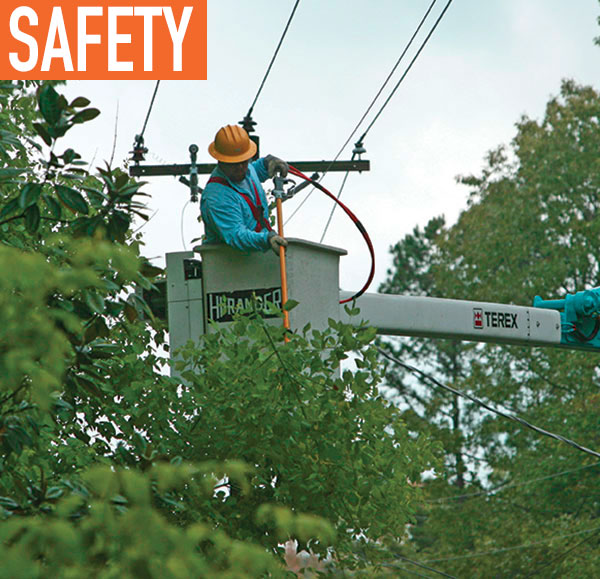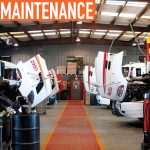One of the biggest challenges for utility crews on any jobsite is being exposed to traffic. Line personnel need to take traffic control efforts seriously, including paying attention to signs before and after the work area to catch the attention of drivers sharing the road.
“If you determine during the site survey and set up that the jobsite is not safe,” says Jim Olson, product and safety engineer, Terex Utilities, “you should not operate in the area until you can make it safe for your crews, your equipment, and the community.”
It is important always to clear the area of bystanders and miscellaneous obstacles and jobsite debris, including downed power lines and fallen tree limbs. “Remember, tree limbs can become energized when touching a live power line,” says Olson.

Featured Image: Avoid placing booms, buckets, or personnel closer to energized electric power lines than the applicable minimum approach distance for the nominal voltage of the energized electric power lines on the site.
Above: Operating in extreme weather conditions requires that you take extra precautions to protect your crew and truck.
OPERATION
As work begins, Olson offers simple operating tips to be safe and productive throughout the project.
“When operating the boom, operate in smooth, gradual movements—avoid abrupt starts, stops, and reversal of direction,” says Olson. Always be aware of your boom’s trajectory before you begin operating. “Never operate the boom in a position where it can be exposed to the path of open traffic lanes.”
Aerial devices are designed to lift personnel, do not use them to lift or lower objects unless the aerial device was specifically designed and equipped to do so, advises Olson.
Once the bucket is raised and the boom is in motion, do not adjust outriggers—and you should never move the vehicle while personnel are in the bucket. “Operators must always stand with both feet on floor of the bucket—do not sit or climb onto the edge or use planks, ladders, or other devices to gain additional work height,” says Olson. “To protect your entire crew from falling debris or objects, it is important to keep ground personnel out from under the aerial device work area.”
Also, make sure that no part of your bucket truck, including the boom and platform, come into contact with fixed objects like trees, buildings, or utility poles, adds Olson. Always maintain proper minimum approach distance from energized power lines. Your bucket truck cannot protect you from phase-to-phase or phase-to-ground contact, which means you need to allow for sag, sway, or rocking as you are positioning and operating your aerial device.
Never place booms, buckets, or personnel closer to energized electric power lines than the applicable minimum approach distance for the nominal voltage of the energized electric power lines on the site, says Olson, warning that if any part of the boom touches an energized object, it should be considered energized. If any part of the boom contacts a grounded object, it should be considered grounded.
If you become aware of any dangerous condition, unusual operation, or unusual sound while operating your bucket truck, stop all movements immediately. “Do not move the truck until the problem has been diagnosed and resolved—your safety is priority,” says Olson. “No matter how long it may take to get help, it’s critical to the safety of the operators—and bystanders—to resolve the situation using good judgment and common sense.”
POST-OPERATION
When the project is done, it is important to follow these safe practices to protect your truck and crew, says Olson. Lower the boom to fit securely in the boom rest and lock it into place with the hold down system to prevent bouncing during transport. You should never travel with personnel, tools, or any objects in the platform or with the boom raised. Stow and secure all tools, gear, and loose items in your truck to prevent falling onto the roadway. All personnel need to ride in the truck’s cab with safety belts on. “Always drive carefully and obey all traffic laws,” says Olson.
Before leaving the jobsite, fully retract the outriggers and disengage the PTO unit.
“Depending on the jobsite conditions, we may even wash down the trucks before leaving the area to make sure we don’t transfer jobsite materials from one site to the next,” says Garry Christopherson, director, safety and security, Dairyland Power Cooperative.
Once you are back to the shop, inspect, maintain, clean, and repair the bucket truck according to manufacturer’s guidelines. Keep up with preventive maintenance inspections as required by the manufacturer, finishes Olson.

If you become aware of a dangerous condition, unusual operation, or unusual sound while operating your bucket truck, stop all movements immediately.
TRAINING
To effectively and efficiently use your bucket truck, OSHA standards require that operators must be qualified to operate the machine, says Olson. Bucket truck manufacturers are required to provide operator’s manuals with each truck, but it’s the employer’s responsibility to ensure that individual operators are properly trained and qualified to operate the aerial device in the expected working environment.
“Bucket trucks are designed to lift you and your tools to an aerial worksite,” concludes Olson. “The best way to keep you safe, and your truck productive, is to familiarize yourself with the manufacturer’s operator’s manual and commit to following all of its safety guidelines and requirements.” To supplement in-house training programs, Terex offers “The Edge” online training courses—based on information outlined in the operator’s manual—that can be accessed at any time, from any computer.
At Dairyland Power, Christopherson says the company conducts four-day training sessions that include both classroom and hands-on learning. They also work with their equipment manufacturers, like Terex, to develop strong training programs based on the operator’s manuals and practical applications. “We work with Terex to provide in-depth, ongoing training to our crews on the equipment,” says Christopherson. “Operators need to be able to assess the situation and make decisions based on what is going on.”
ABOUT THE AUTHOR:
Amber Reed is president of Signature Style PR + Marketing, a PR and content marketing firm. Find out more about Ms. Reed, visit www.signaturestylepr.com.
_______________________________________________________________________
MODERN WORKTRUCK SOLUTIONS: APRIL 2016 ISSUE
Did you enjoy this article?
Subscribe to the FREE Digital Edition of Modern WorkTruck Solutions magazine.
![]()




